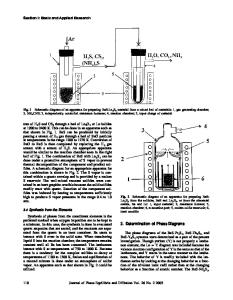Extraction equilibria in the system GaCl 3 -AlCl 3 -HCl-H 2 O-tributyl phosphate
- PDF / 611,192 Bytes
- 7 Pages / 603.28 x 783.28 pts Page_size
- 73 Downloads / 291 Views
.
INTRODUCTION
SOLVENT extraction of gallium from hydrochloric acidalumina liquors is of potential interest when processing gallium-bearing aluminum ores by the acid route. The concentration of gallium in the ores ranges from an average of 20 ppm to 50 ppm in a typical case,l with the Ga:AI ratio in the order of 1 : 1 x 104. Numerous studies report distribution ratio data of gallium in the system HC1-HzO-tributyl phosphate (TBP). 1-~~The extraction of gallium from a hydrochloric acid medium is characterized by a very strong dependence on acid concentration. Two extraction mechanisms have been confirmed. At zero and low acid concentrations, gallium is extracted as an electrically neutral complex GaCI3. 5'u At high acidities, the presence of an anion complex GaCff is credited with the observed enhanced extraction. 4'7'9 Depending on the concentration of the metal, the neutral GaC13 complex is reported to be either mono- or disolvate ~2with less than two moles of water, u A slope analysis indicated7 that the anion complex species GaCff is extracted as a trisolvate. Partial dissociation of both gallium and hydrochloric acid species in the organic phase has also been reported. 9A3'14 Data on phase equilibria and distribution of gallium in the mixed electrolyte system GaC13-A1C13-HC1-H20-TBP have thus far not been reported in the literature. The objectives of this research are to examine the phase equilibria and complex species equilibria of this system, to define the controlling variables in the extraction of gallium, and to develop a simple chemical thermodynamic model to predict the extraction of gallium.
VESA-PEKKA JUDIN, formerly Visiting Scientist, Ames Laboratory, USDOE, is with Kemira Oy, Oulu Research Laboratory, P.O. Box 171, SF-90101 Oulu, Finland. RENATO G. BAUTISTA is Professor, Department of Chemical and Metallurgical Engineering, University of Nevada, Reno, NV 89557. Manuscript submitted September 5, 1985.
METALLURGICALTRANSACTIONSB
II.
EXPERIMENTAL PROCEDURE
A. Chemicals
Reagent grade tributyl phosphate obtained from Fisher Scientific was used after purification 15 and without purification. The purification typically reduced the hydrogen concentration (acidity) of TBP from 0.006 M to 0.005 M H +, as detected by potentiometric titration. The extraction results were not enhanced by the purification step. Asreceived TBP was used in all subsequent tests. HC1 stock solutions were prepared from electronic grade hydrochloric acid obtained from Allied Chemical. The concentration of HC1 was determined by potentiometric titration against standard 0.1 m NaOH. Sodium hydroxide was standardized against potassium hydrogen phthalate. Reagent grade aluminum chloride hexahydrate, obtained from Fisher Scientific, was analyzed gravimetrically for A1 and C1, and by Karl Fischer titration for H20. The AI:C1 mole ratio was 1:3.005 and the purity of the salt was 99.85 pct. The gallium stock solution was prepared by dissolving high-purity gallium metal (99.999 pct) obtained from Alfa Products in concentrated hydrochloric a
Data Loading...











